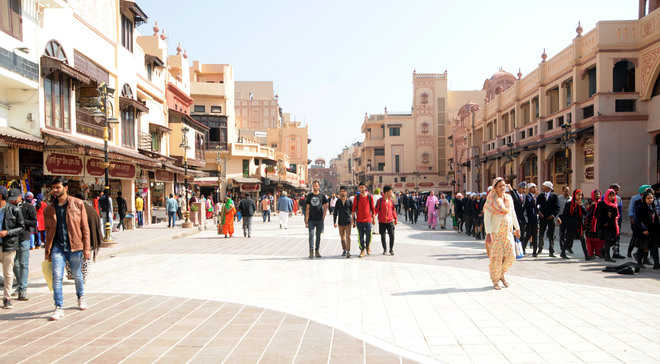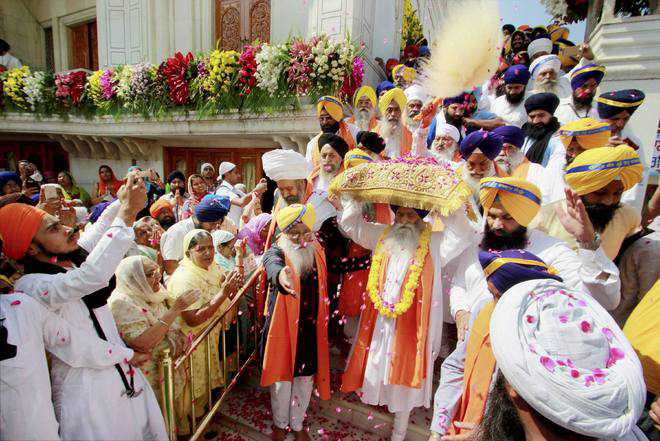
The old Katra Ahluwalia street in the walled city in Amritsar. Photo: Vishal Kumar

The modern Heritage Street near Golden Temple in Amritsar. Photo: Vishal Kumar
Manmeet Singh Gill
Tribune News Service
Amritsar, October 6
Since the fourth Sikh master, Guru Ramdas Ji laid its foundation 440 years ago, the holy city of Amritsar, historically known as Ramdaspur and colloquially referred to as Ambarsar, has seen vast changes in its heritage. But, what has not changed is its street pattern and its nomenclature. The whole community and the city in particularly will be celebrating its founder’s birth anniversary on October 7 (Saturday).Till date, one of the first settlements in Amritsar after Gurus invited artists of 52 trading communities to inhabit the city is known as Chownk Passian. The name Passia has lived long though the other characters of the area have changed.Prof Balvinder Singh, adviser to Indian Heritage Cities Network (IHCN) said, “Passa was a gold ornament worn by women on their heads. The area was inhabited by goldsmiths and hence the name Passian struck. Further, the gold which came in the form of a lump or ingot, was locally referred to as Passa.”Although the work to set up the city was started by the fourth Sikh master, it began taking shape after the fifth Sikh master, Guru Arjan Dev, was installed on Gurgaddi in 1581. It was during his period that most area (measuring around 3.52 sq km), now called the walled city, was developed.The streets in the time were mostly named on the basis of caste and profession. Gali Mochian and Gali Acharjan is the name of community, which performs rituals at the time of cremation of the dead and in lieu of that they are entitled to hold personal belongings of the deceased. Telia Wali Gali is an example of the same.Another wonderful character of the street layout of the time is a narrow lane leading to a square with residential buildings having big tree in the centre. The professionals of the architecture term this character as “Surprising open spaces”. Much of the original structure of the city was changed in the period between 1628 to 1765 owing to frequent attacks by the Mughals and damage to buildings due to gun-powder.The period following 1765 to 1802 witnessed massive construction of katras’ (neighbourhoods) named after leaders of the Sikh misls, forts, bungas (resting places for devotees), gardens, and havellis. The 23 different markets — Ghee Mandi, Gur Mandi, Gha (grass) Mandi — are a contribution of the period. At the time, traders of a particular commodity had their shops in the market. This very character of these markets has changed, but nomenclatures still remains the same.The only remaining bunga now is the “Bunga Ramgarhia” built for the defence of Harimandir Sahib. “The watch tower of the bunga was restored recently, but without considering the true conservation techniques,” commented Prof Balvinder Singh.It was in the era of Maharaja Ranjit Singh (1802-1849) that a massive wall (with 12 gates) of unbaked bricks, with a double moat was constructed around the city in 1825. This fortification (wall) was 25 yard broad and seven yard high.Amritsar was made a district headquarter in 1849. The Amritsar Municipal Corporation came into being in 1868. It was in the following years that the original wall was demolished by the British and later, a new one was built.Prof Balvinder Singh said, “Much of the built heritage has been demolished due to faulty conservation or lack of awareness. Still the original character can be restored or conserved because it reflects the intangible component in terms of values, lifestyle of the inhabitants. It is this common heritage which binds us.”
Interesting facts
- One of the first settlements in the city is at Chownk Passian.
- Much of the original structure of the city changed in the period between 1628 to 1765 owing to frequent attacks by the Mughals.
- The only remaining bunga now is the “Bunga Ramgarhia” built for the defence of Harimandir Sahib.
- A massive wall (with 12 gates) of unbaked bricks, with a double moat was constructed around the city in 1825 during the era of Maharaja Ranjit Singh.
- Amritsar was made a district headquarter in 1849.
- The Amritsar Municipal Corporation came into being in the 1868
Nagar Kirtan held to mark Gurpurb
Founder of holy city had settled here people from 52 vocations

Devotees take part in a procession on the birth anniversary of the fourth Sikh Guru, Guru Ramdas Jee, at the Golden Temple in Amritsar on Friday. PTI
Tribune News Service
Amritsar, October 6
A grand Nagar Kirtan was held to mark the 484th birth anniversary of the fourth Sikh Guru, Guru Ram Das, in the holy city here today.Apart from the Sikh sangat, people from other faiths also took part in the Nagar Kirtan held on the Gurpurb of the city’s founder.The religious procession commenced from Akal Takht where the Head Granthi of Golden Temple, Giani Jagtar Singh, placed Guru Granth Sahib in the palanquin.En route the Nagar Kirtan, shopkeepers of all religions had cleaned the roads in front of their shops, beautified them and lit candles to welcome the religious procession.Devotees from all over the world took part in the Nagar Kirtan, including the USA, and inmates of the Miri Piri Academy. Employees of the SGPC had tied up ribbons on their turbans on which “Dhan Dhan Sri Guru Ram Das Jee” was printed.Schoolchildren, band parties, gatka groups, Nihang groups and others took part in the Nagar Kirtan which passed from different areas of the city. The SGPC president, Kirpal Singh Badungar, thanked different organisations and people to make the Nagar Kirtan a grand success. He said the founder of the holy city had settled people from 52 different vocations in the city for its overall growth.Golden Temple was illuminated with sophisticated LED lights and the sanctum sanctorum was beautified with flowers brought from different countries by the sangat from Mumbai. A ‘deepmala’ was also arranged at Sri Guru Ram Das Jee International Airport, the railway station, the ISBT, the Attari-Wagah Joint Check Post, the elevated road and other prominent public buildings. Various educational institutes also held religious programmes.

